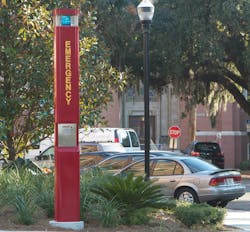Tech Spotlight: The Evolving Role of MNS
Advances in modern technology continue to improve how we interact with each other and the world around us. Archaic systems and products are being replaced with more advanced versions; and, many new technologies that were originally designed for one application are beginning to cross over into new areas. Following suit, security technologies offer several new options and capabilities that go beyond the typical uses in traditional applications.
Bringing together two technologies to complete a robust, full-service solution that offers more than just security for the end-user is not only possible, but also becoming increasingly desired. Integrators who embrace the chance to extend security technology into new applications will position themselves as cutting-edge solutions providers.
The Changing Role of MNS
A mass notification system’s (MNS) primary objective is to disseminate one-way communication to individuals or groups of individuals in the event of an emergency. They provide the fastest way to deliver a message to the masses when a crisis situation arises; however, with advancements in software technology and successful systems integration, mass notification systems have taken on a much broader scope of functionality.
In addition to having the ability to send an intelligible audio broadcast to an enabled security communication device, new mass notification technology is making it possible for organizations to establish two-way communication to improve both internal and external operational processes. Additionally, recent changes made to NFPA 72 2010 make it allowable for emergency communication systems to broadcast informational messages.
Three delivery models for a mass notification platform are available — including hosted software, on-premise or a hybrid of the two. While all three models make it easy to send thousands of notifications through text messages, email, landline phones, pagers, fax and BlackBerry Messenger, the future looks especially bright for the cloud-based version that is available as a software-as-a-service (SaaS). The hosted application is available off-site, where users can gain instant access to send alerts from a mobile or Web app through real-time connectivity to the Internet. The hosted platform requires no hardware or software installation.
The new mass notification technology is empowering corporations, educational institutions and government agencies with new ways to use their existing communication tools beyond typical security functions.
Campus Applications
Colleges and universities embraced mass notification technology early on as a way to send emergency messages to students, staff and visitors on campus. Emergency communication systems aren’t just for emergencies anymore; in fact, many colleges and universities rely on mass notification to streamline day-to-day communications since the changes made to NFPA 72 2010.
Here are some of the ways college campuses are using emergency notification systems to communicate informational messages:
1. Campus evacuations: Use notification to alert students, staff and faculty of dangerous situations like bomb threats or chemical spills. Direct them to avoid the area of impact while notifying police and emergency responders.
2. Security team management: The devices can be used to alert security teams to potential incidents and to request a quick location response from each guard to help better manage a situation.
3. Health warnings: Notify students and faculty when there is an outbreak on campus, alerting them to risk, directing them to resources, describing warning signs and explaining which symptoms need immediate attention.
4. Class or building closing: When storms hit, these systems are being used to alert students of canceled classes or building closures caused by unsafe conditions, flooded parking lots or power outages.
5. Staffing changes & updates for faculty and students: Universities can use notification devices to put out a call for qualified alternates when teachers are unable to make it to class. They can also notify faculty about a meeting update; alert students if a class venue has changed; remind them of approaching or shifting deadlines; inform of special events; or a change in office hours.
6. IT uptime: Notification can streamline internal IT operations; quickly alert appropriate IT team members when systems lag or fail.
Samuel Shanes is Chairman and CEO of Talk-a-Phone. To request more information about the company, please visit www.securityinfowatch.com/10215291.
About the Author
Samuel Shanes
Samuel Shanes is Chairman of Talk-a-Phone. To request more information about the company, visit www.securityinfowatch.com/10215291.
